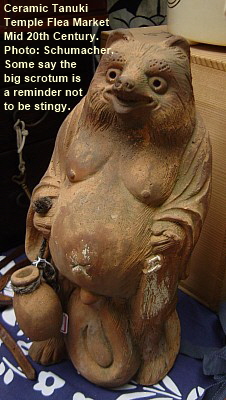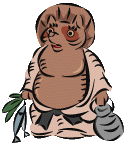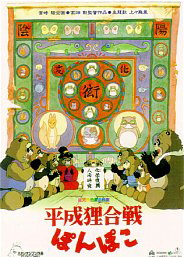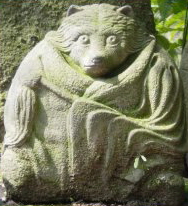|
|
|
|
たぬき

TANUKI, ODANUKI, MUJINA
Magical Racoon-like Dog with Shape-Shifting Powers
Modern-Day God of Gluttony, Boozing, and Restauranteurs
 Mythical & Magical Tanuki. Tanuki 狸 appear often in Japanese folklore as shape-shifters with supernatural powers and mischievous tendencies. Animals with the power of transformation -- for either benevolent or malevolent purposes -- are called Henge in Japan. In Japanese folklore, the Kitsune (fox) and Tanuki (this page) are considered masters of transformation, as is the Tengu, the bird-man goblin of the forest and mountain who is revered as the slayer of vanity and pride. Tanuki statues are found everywhere around Japan, especially outside restaurants and bars, where the Tanuki beckons drinkers and dinners to enter (similar to the role played by Maneki Neko, the Beckoning Cat, who stands outside retail establishments). The beckoning Tanuki is most often depicted with a big round tummy, gigantic testicles, a flask of sake, a promissory note, and a straw hat. Mythical & Magical Tanuki. Tanuki 狸 appear often in Japanese folklore as shape-shifters with supernatural powers and mischievous tendencies. Animals with the power of transformation -- for either benevolent or malevolent purposes -- are called Henge in Japan. In Japanese folklore, the Kitsune (fox) and Tanuki (this page) are considered masters of transformation, as is the Tengu, the bird-man goblin of the forest and mountain who is revered as the slayer of vanity and pride. Tanuki statues are found everywhere around Japan, especially outside restaurants and bars, where the Tanuki beckons drinkers and dinners to enter (similar to the role played by Maneki Neko, the Beckoning Cat, who stands outside retail establishments). The beckoning Tanuki is most often depicted with a big round tummy, gigantic testicles, a flask of sake, a promissory note, and a straw hat.
 Real Tanuki. The Tanuki is also a real animal. It is often confused with the badger (ana-guma) and the racoon (arai-guma). It is neither -- it is an atypical species of dog that can grow up to 60 cm. in length, with distinctive stripes of black fur under its eyes. The Tanuki is reportedly native to Japan, southeastern Siberia and Manchuria. Some were introduced to western parts of the Soviet Union for fur farming in the 1950s, and have since spread into Scandinavia and as far south as France. Scientific Name: Canis Viverriuns, Nyctereutes, Procyonoides. Belongs to the dog family. View Japan Times articles describing real Tanuki or read story by Aichi Center for Japanese Studies. See bottom of this page for two more photos of the real-life Tanuki. Real Tanuki. The Tanuki is also a real animal. It is often confused with the badger (ana-guma) and the racoon (arai-guma). It is neither -- it is an atypical species of dog that can grow up to 60 cm. in length, with distinctive stripes of black fur under its eyes. The Tanuki is reportedly native to Japan, southeastern Siberia and Manchuria. Some were introduced to western parts of the Soviet Union for fur farming in the 1950s, and have since spread into Scandinavia and as far south as France. Scientific Name: Canis Viverriuns, Nyctereutes, Procyonoides. Belongs to the dog family. View Japan Times articles describing real Tanuki or read story by Aichi Center for Japanese Studies. See bottom of this page for two more photos of the real-life Tanuki.

Magical Tanuki
In Japanese lore, Tanuki are shape-shifters with supernatural powers.
Tanuki statues are commonly placed in front of bars and restaurants.
Photo courtesy Robert Yellin.


|

Photo: www.odanuki.com
Tanuki Okimono (carved wood object, Meiji Era, artist unknown); shows Tanuki walking with an umbrella and carrying a sake bottle.
Among okimono potters, Miwa Kiraku Vl is considered one of the most prolific. Many of his works are distinguished by a soft greenish celadon glaze; his motifs include the mythical shishi lion and the cunning Tanuki.
|
|
 Tanuki Tales. There are countless tales about the mischievous Tanuki. The Tanuki can transform into any living or inanimate shape, but in legend it often assumes the form of a monk or a tea kettle to play tricks on people. Real Tanuki live in the lowlands, forests and mountain valleys, and in legends, the mythical Tanuki is most often shown playing tricks on hunters and woodsmen. They can cast powerful illusions -- they can turn leaves into fake money or horse excrement into a delicious-looking dinner. Tanuki Tales. There are countless tales about the mischievous Tanuki. The Tanuki can transform into any living or inanimate shape, but in legend it often assumes the form of a monk or a tea kettle to play tricks on people. Real Tanuki live in the lowlands, forests and mountain valleys, and in legends, the mythical Tanuki is most often shown playing tricks on hunters and woodsmen. They can cast powerful illusions -- they can turn leaves into fake money or horse excrement into a delicious-looking dinner.
The Tanuki is said to love Japanese sake (rice wine), and is often depicted with a sake bottle in one hand (usually purchased with fake money made from leaves) and a promissory note in the other (a bill it never pays).
The Tanuki is also known in some localities as Mujina 狢 or 貉. Indeed, about one century ago, the Japanese court system ruled that the Tanuki and the Mujina were the same species. When hunting of tanuki was prohibited by law, one hunter claimed he was out hunting mujina, not tanuki. The court threw out his case -- that is, he lost the case. (need to find SOURCE)
SHIGARAKI & TANUKI. The Tanuki is synonymous with modern-day Shigaraki (Shiga Prefecture). Shigaraki-style pottery, which traces its origins back to the 12th century, is one of Japan’s most beloved ceramic styles. But the Shigaraki staple most folks are familiar with today is not Shigaraki tsubo (large ceramic jars), but rather the pudgy ceramic Tanuki that stands in front of drinking establishments throughout Japan. It holds a sake flask in one hand and in the other, a promissory note for the booze; it never pays, though. If you've ever been to Shigaraki, you cannot miss the numbing variety of garish tanuki that stand in front of many tourist shops. <above quote courtesy Robert Yellin>

Two Glazed Ceramic Tanuki - from www.jcollector.com
From the Taisho Period; straw hat and sake bottle in hand
 MESSAGE FROM MATTHEW COMBS. The symbol on Tanuki’s sake bottle is sometimes identical to the emblem (adopted in 1907) of Nagoya City. The symbol was used by the rulers of the Nagoya area in feudal days. It is the Japanese character "Hachi," which means “eight,” and it stands for the eight districts controlled by the Nagoya clan in those bygone days. On some statues of Tanuki, HACHI is written on the sake bottle (see above photo at left and photo below). Shigaraki is not far from Nagoya, so this might indicate why the symbol is used, as Shigaraki may have been part of the Nagoya domain in feudal times. MESSAGE FROM MATTHEW COMBS. The symbol on Tanuki’s sake bottle is sometimes identical to the emblem (adopted in 1907) of Nagoya City. The symbol was used by the rulers of the Nagoya area in feudal days. It is the Japanese character "Hachi," which means “eight,” and it stands for the eight districts controlled by the Nagoya clan in those bygone days. On some statues of Tanuki, HACHI is written on the sake bottle (see above photo at left and photo below). Shigaraki is not far from Nagoya, so this might indicate why the symbol is used, as Shigaraki may have been part of the Nagoya domain in feudal times.


Tanuki statues are a common sight in Shigaraki.
Photo courtesy Robert Yellin.

 What About Those Big Testicles? What About Those Big Testicles?
A curious and defining characteristic of Tanuki is its gigantic testes. In Japanese slang, these are known as Kinbukuro 金袋, or “money bags.” The magical Tanuki loves drinking and eating, and statues of this creature often stand outside bars and eateries, beaconing visitors to enter. Some therefore say that Tanuki’s big testes are a reminder not to be stingy. By extention, it is no stretch of the imagination to consider the Tanuki to be over-sexed.
In other legends, the testicles / scrotum can be stretched to the size of eight tatami mats. Others point to the word Senjojiki (the space of 1,000 tatami mats) as an indication of the Tanuki’s testes size. Called Kin-tama 金玉 (Golden Jewels) in Japanese, the testes are supposedly symbols of good luck rather than overt sexual symbols (the Japanese are more tolerant of low humor than most Western nations). In the Japanese movie Heisei Tanuki Gassen Ponpoko (see below), the Tanuki stretches out its scrotum as a parachute in a desperate suicide attack. In other Tanuki folklore, the Tanuki uses the testes as an impromptu drum, beating out the “ponpoko” sound (no pun intended).
In biological terms, the mythical Tanuki’s large “golden balls” are a true depiction of the real-life Tanuki. According to evolutionary biologists, the Tanuki’s scrotum is large because of fierce competition among Tanuki males for females. Phrased differently, Tanuki copulate frequently, and those Tanuki with larger testes size have a greater chance of getting their genes into the next generation. The same is true in the world of chimpanzees.
Donald Richie, in his review of Nicholas Bornoff’s book “Things Japanese,” has this to say:
The Tanuki makes an appearance, holding an empty sake bottle in one paw, an account book in the other -- signifying that this money was wasted on wine and women. As Bornoff tells us: "Some say that the vast scrotum is due to sexual overindulgences but, since his penis has disappeared, another interpretation is more likely" -- an entertaining aside from the author of "Pink Samurai: An Erotic Exploration of Japanese Society."

Tanuki with his male member still intact !!!
Found outside shop in Kamakura City.
Very uncommon to find statues of Tanuki
with the “male member” still intact.

 What About the Leaf on Its Head? What About the Leaf on Its Head?
The shape-shifting Tanuki is said to put leaves on its heads and to chant prior to transformation. In some legends, the leaf is the sacred lotus plant of Buddhism. It is also believed that Tanuki can change leaves into money (as one of them did in Heisei Tanuki Gassen Ponpoko). In the computer game "Super Mario Brothers," when Mario gets a leaf, he gains pointy ears and the tail of a Tanuki.
What About the Straw Hat?
Tanuki’s straw hat reportedly symbolizes the virtue of “readiness” -- be prepared for bad weather or bad luck.

 Bunbuku Chagama Bunbuku Chagama
The Tea Kettle Story
This story comes in many versions. In one, a poor woodsman saves the life of a Tanuki. In thanks, the Tanuki transforms itself into a chagama (tea kettle) that the poor man sells to a priest. The priest takes it back to his temple, where he orders his staff to clean it and make some tea. As you might imagine, the Tanuki was very unhappy with his role as a cooking utensil, for it hurt to be polished and used on the fire. After a time, the Tanuki escapes the temple and returns to the woodsman, and thereafter makes money for the “woodsman-turned-traveling-entertainer” by dancing as a kettle on a tightrope. In another version, a priest tries to catch a Tanuki to eat for dinner, but the Tanuki escapes by changing itself into a tea kettle, which the priest takes back to the temple. But when the priest places the kettle on the fire to make some tea, the kettle sprouts limbs and soon resumes its true Tanuki form. In the movie Heisei Tanuki Gassen Ponpoko (see below), the chagama is the black round thing the Tanuki children are trying to change into when they are training.
|

|
|
The Lucky Tea Pot of Morinji Temple
Story about a Tanuki who transforms into a teapot that never runs out of tea. The teapot becomes the favorite of the temple monk. Here the Tanuki has briefly assumed human form. There are many variations of this story.
Photo. Woodblock by Yoshitoshi Tsukioka 月岡 芳年; New Forms of 36 Apparitions, 1889-1892. Entitled: The Lucky Tea Pot of Morinji Temple; image courtesy of Nagoya TV.
|
|
|
|

 Tale of Kachi-Kachi Yama Tale of Kachi-Kachi Yama
This story portrays Tanuki as an evil creature. He robs from the field of an old farmer, but is caught by the farmer’s wife. To regain his freedom, he lies to her, and once released, he kills her and runs away. But the old farmer, with the help of a rabbit (usagi), avenges her death. In one section of the story, the rabbit and Tanuki are gathering firewood. On the way home, the rabbit tries to set fire to the wood on Tanuki's back. When Tanuki asks the rabbit "What's that sound," the rabbit replies "Don't you know? Kachi-Kachi is the Japanese word for the sound made when using flint to light a fire. In the final scene, the rabbit and Tanuki are having a boat-racing contest, but since the Tanuki’s boat was made from mud, it sinks in the middle of the lake, and the Tanuki drowns. The motto of the Shikoku Tanuki Train Line is: "Our ship isn't made of mud."
 Relationship to Magical Kitsune (Fox) Relationship to Magical Kitsune (Fox)
Kitsune (fox) are the messengers of the god Inari in Shinto belief. Since the Tanuki does in fact look somewhat like a fox, it may be that the lines between the two magical beasts became blurred over the centuries. It also seems likely that Tanuki lore is indiginous to Japan, and that linkages between the Tanuki and Kitsune appear only after the 6th or 7th century AD, when Korean and Chinese mythology is introduced to Japan. One final note -- in the movie Heisei Tanuki Gassen Ponpoko, a Tanuki changes into a white fox, and scares the wits out of the people who want to move a Shinto shrine to develop the land.
Above Photo. Tanuki at Kanjizai-ji Temple, Shikoku, courtesy:
http://hirotaku.web.infoseek.co.jp/temple/shikoku/shik40.shtml

|
Tanuki Movie, Song, and Lyrics
In a very famous children's song, "Shojoji no Tanuki Bayashi," the Tanuki beats its tummy, singing a song, having fun under the moon. The refrain of the song says "Ponpoko Pon no Pon.” This is the sound made by Tanuki beating its tummy or “golden balls.”
Japanese Movie Name = Heisei Tanuki Gassen Ponpoko
English Movie Name = Pom Poko
Song = Shojoji no Tanuki Bayashi (証城寺の狸囃子)
Literally = Racoon Dogs Dancing at Shojoji Temple.
Written by Nakayama Shinpei. Lyrics by Noguchi Ujo.
|
|
 Heisei Tanuki Gassen Ponpoko Heisei Tanuki Gassen Ponpoko
Heisei-era Tanuki Battle Ponpoko
Movie Poster from popular 1994 movie directed by Isao Takahata. “Heisei” is the name of the era of the current Japanese emperor (Akihito). ”Ponpoko” is the sound made by a Tanuki beating its tummy or its “golden balls.”
STORY: Tanuki community is driven away from natural mountain habitat by humans, who are developing the area into a gigantic residential site. The movie also refers to a Tanuki named “Kincho,” who is apparently very famous in Kagawa, Shikoku.
LEARN MORE ABOUT THE FILM (outside sites)
|
|
証 証 証城寺
証城寺の庭は
ツ ツ 月夜だ
みんな出て 来い来い来い
おい等(ら)の友達ァ
ぽんぽこ ぽんの ぽん
負けるな 負けるな
和尚(おしょう)さんに 負けるな
来い 来い 来い
来い 来い 来い
みんな出て 来い来い来い
証 証 証城寺
証城寺の萩(はぎ)は
ツ ツ 月夜に 花盛り
おい等(ら)は浮かれて
ぽんぽこ ぽんの ぽん
|
Sho sho Shojoji
Shojoji no niwa wa
Tsu tsu tsukiyo da
Minna dete koi koi koi
Oira no tomodacha
Pon poko pon no pon
Makeruna makeruna
Osho-san ni makeruna
Koi koi koi, Koi koi koi
Minna dete koi koi koi
Sho sho Shojoji
Shojoji no hagi wa
Tsu tsu tsukiyo ni hana zakari
Oira wa ukarete
Pon poko pon no pon
|
|
At Shojoji Temple
In the temple garden
In the moonlight
Come on everybody
My friends play belly drums
Pon poko pon no pon
Don't loose your dancing bout
Against the monk
Come here, come here
Everybody come here and dance
At Shojoji Temple
The temple’s bush clover
Is in full bloom under the moon
I’m in a festive mood
Pon poko pon no pon
(sound of playing belly drum)
About the composer, Nakayama Shinpei (outside site)
|
|
Order Movie DVD |
Includes Tale of Kachi Kachi Yama |
|

Click-Clack Mountain (Kodansha Children's Classics Series)
by Ralph McCarthy.
Includes Kachi-Kachi Yama
|

The Dancing Kettle and Other Japanese Folk Tales
By Yoshiko Uchida
Includes Bunbuku Chagama story
|
|
|
|


|
Stone statue at Zuisenji Temple, Kamakura
Looks like a fox (kitsune), but probably a tanuki.
Writes site visitor Michael: This appears to be a tanuki, not a fox, because of the creature's enormous girth, typical of tanuki in traditional art, and because of the slightly confused expression on its face (tanuki are not thought to be very bright) !
|
|

OTHER WRITINGS, LORE, AND TANUKI TRIVIA
- Harada, Violet H. (1976). The Badger in Japanese Folklore. Asian Folklore Studies, V35, pp. 1-6. Nanzan Institute for Religion and Culture. Says Harada in her conclusion: “The badger in Japanese folklore is a complex creature possessing special powers and capable of assuming a hundred shapes. It chants Buddhist sutras and makes merry with its belly-drum. It tricks unwary peasant travelers and devout priests and metes out revenge in its own cruel ways. Sometimes the duped, more often the irrepressible trickster, the badger weaves a unique magic in the oral tradition of Japan.” <end quote>
- M.W. De Visser, "The Fox and the Badger in Japanese Folklore," in Transactions of the Asiatic Society of Japan, vol. XXXV1 (1908), p. 1.
- Animal Motifs in Asian Art: An Illustrated Guide to Their Meanings and Aesthetics. Author Katherine M. Ball. Courier Dover Publications, 2004. First published 1927. The badger (i.e., Tanuki) is discussed on pages 141 - 146.
- www.odanuki.com. Because of its pot belly, the Tanuki is associated with two other figures with large stomachs, the Fugu (blow) fish and Hotei, the fat God of Luck. The famous Shogun, Ieyasu Tokugawa, was irreverently referred to as Furu Tanuki (Old Tanuki). In a priestly disguise, the Tanuki wraps itself in lotus leaves, with a lotus flower doing duty as a hat.
- Food - Tanuki Soba. Tempura batter flakes are sprinkled on the top, and melt into a jellylike sauce. Named after the Tanuki, perhaps because the tempura flakes don’t contain vegetables, fish, or more hearty substances. The batter flakes are just another “illusion” cast by the mischievous Tanuki, for when you bite into the tempura, you don’t get any “substantial” food.
- Historical Tanuki. Some of the oldest Tanuki legends hail from Shikoku. “Kincho” is the name of one of these legendary Tanuki.
- Kabuki. "Tanuki (Badger)," written by the noted historical novelist Jiro Osaragi. First presented in 1953, it is a modern sewamono comedy.
- Below text by Norman A. Rubin, Asianart.com. www.asianart.com/articles/rubin/
The Japanese tanuki and the fox (kitsune) are the most popular animals attributed with magical powers. They have similar roles in folklore. They are pictured as mischievous rogues who often get themselves into trouble. They can, at times, be frightening creatures, and at other moments be capable of making a negative situation positive. Sometimes they are treated as godly figures and become cultural heroes. The ‘tanuki’ is sometimes seen as a witch, a cannibal monk, or a one-eyed demon who murders his victims with thunder, lightning or earthquakes. Sometimes he is depicted humourously, having a gigantic scrotum which he drags behind him or wears it as a kimono. In some Netsuke figures the tanuki appears as a Buddhist monk dressed in robes and banging on his scrotum as if it were a temple drum.
- www.harapan.co.jp/english/JPImage_e/tanuki.htm
- The Obakemono Project - Tanuki Page
Gaijin's Guide to the Fantastic Folk Monsters of Japan

Five real Tanuki feeding in garden of Dr. Gabi Greve
Photo copyright Dr. Gabi Greve

Baby Tanuki, photo by Adam Nuelken

Last Update: Dec. 2010
Added Photo of Baby Tanuki | Why are Tanuki’s testes so large?
Added Photo with Tanuki’s “Male Member” Still Intact
|
|